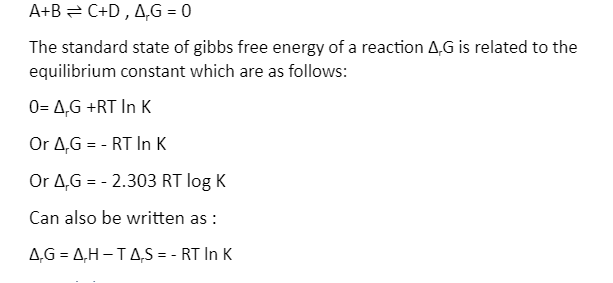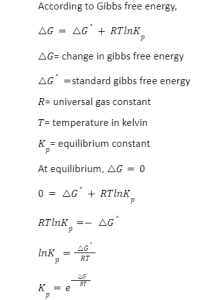Introduction
To explain the changes in both entropy and enthalpy, J. Willard Gibbs has defined a new function called Gibbs energy change or Gibbs potential G. This function is independent of variation in pressure and temperature. The change in Gibbs energy depends only on the state of the system, not on how that state was achieved.
The change in Gibbs energy associated with the formation of a compound from its component elements under standard conditions is known as the standard Gibbs free energy of formation. The concepts of free energy of a process like a rate or an equilibrium and the free energy of a standard process often equilibrium, which may be the process under investigation or other standard reaction.
Standard Gibbs free energy
The maximum work (or reversible) work that can be done by a thermodynamic system at constant pressure and temperature is known as the Gibbs energy. Reversible work in thermodynamics means a method where work is performed in such a way that the system is in perfect equilibrium with its environment. In relation to chemical reactions, the word reversible means that the reaction can be carried out in both directions simultaneously and a dynamic equilibrium is always maintained. This further means that reactions should proceed in both directions with a decrease in free energy, which seems to be impossible. This is only possible if, in equilibrium, the system’s Gibbs energy reaches its minimum value. Otherwise, the system will spontaneously switches to the configuration of lower free energy.
The equation/formula of Gibbs free energy
We can say a thermodynamics system is in equilibrium when it’s intensive properties such as temperature and pressure and extensive properties (U,G,A) are constant. By seeing the equation given below we can say that if the reaction is reversible and the Gibbs free energy is zero , then the system will be in equilibrium.

For endothermic reaction
For a reaction to be endothermic ,the value of change in enthalpy of a reaction (∆rH) is large and positive , in this the process is spontaneous under two conditions:-
- Temperature should be very high to make the Gibbs free energy value negative.
- Change in entropy should be very high to make the Gibbs free energy negative.
For exothermic reaction
For the reaction to be exothermic , the enthalpy of the system (∆rH) should always be negative which makes the Gibbs free energy (∆rG) negative.
The unit of Gibbs free energy is KiloJoule . It is usually represented by kJ/mol.
Spontaneity of the reaction
The reaction is favourable which means spontaneous – the value of ΔG is negative.
The reaction is not favourable which means non-spontaneous – the value of ΔG is positive.
The reaction is said to be in equilibrium if the value of gibbs free energy (ΔrG) is zero.
Standard free energy change in biochemical reactions
In biochemical reactions, the standard free energy change is usually expressed as G, which is the free energy change of a reaction in aqueous solution at pH = 7, which roughly corresponds to the conditions inside a cell. Most of the biological reactions (such as the synthesis of macromolecules) are thermodynamically unfavorable (G > 0) under cellular conditions. In order for such reactions to take place, an additional source of energy is required. For example, consider the reaction :
A⇌B ∆G= -10kJ/mol
The conversion from A to B is energetically unfavorable, so the reaction proceeds in the reverse direction rather than the forward direction. However, the reaction could be driven in the forward direction by coupling the A to B conversion with an energetically favorable reaction such as
C ⇌ D , ∆G= +20kJ/mol
When these two reactions are mixed, the coupled reaction can be written as follows:-
A+C ⇌ B+D , ∆G= -10kJ/mol
The G of the combined reaction is the sum of free energy changes of its individual components, so the coupled reaction is energetically favorable and will proceed as described. Thus, the energetically unfavorable conversion of A to B is driven by coupling to a second reaction which is accompanied by a large decrease in free energy. Enzymes are responsible for the coordinated execution of such coupled reactions.
The cell uses this fundamental mechanism to drive many energetically unfavorable reactions that must take place in biological systems. Adenosine-5-triphosphate (ATP) plays a central role in this process by playing a role as a store of free energy inside the cell.
Conclusion
In the above sections the reaction can be interpreted in the broadest possible sense as any change of matter from one form to another. In addition to these chemical reactions, a reaction can be as simple as ice (reactants) turning to liquid water (products), the nuclear reactions which take place in the interior of stars, or elementary particle reactions in the early universe. It doesn’t matter what is the process, the direction of spontaneous change (at constant temperature and pressure) is always in the direction of decreasing free energy.Many reactions in the body should be spontaneous in order for cells to function. Whereas there are some non spontaneous reactions in our body for that we are able to couple them to thermodynamically favorable (exergonic) reactions that allows the cell to perform even more complex functions.
 Profile
Profile Settings
Settings Refer your friends
Refer your friends Sign out
Sign out






